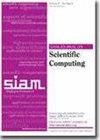Domain Decomposition Learning Methods for Solving Elliptic Problems
IF 2.6
2区 数学
Q1 MATHEMATICS, APPLIED
引用次数: 0
Abstract
SIAM Journal on Scientific Computing, Volume 46, Issue 4, Page A2445-A2474, August 2024.Abstract. With the aid of hardware and software developments, there has been a surge of interest in solving PDEs by deep learning techniques, and the integration with domain decomposition strategies has recently attracted considerable attention due to its enhanced representation and parallelization capacity of the network solution. While there are already several works that substitute the numerical solver of overlapping Schwarz methods with the deep learning approach, the nonoverlapping counterpart has not been thoroughly studied yet because of the inevitable interface overfitting problem that would propagate the errors to neighboring subdomains and eventually hamper the convergence of outer iteration. In this work, a novel learning approach, i.e., the compensated deep Ritz method using neural network extension operators, is proposed to enable the flux transmission across subregion interfaces with guaranteed accuracy, thereby allowing us to construct effective learning algorithms for realizing the more general nonoverlapping domain decomposition methods in the presence of overfitted interface conditions. Numerical experiments on a series of elliptic boundary value problems, including the regular and irregular interfaces, low and high dimensions, and smooth and high-contrast coefficients on multidomains, are carried out to validate the effectiveness of our proposed domain decomposition learning algorithms. Reproducibility of computational results. This paper has been awarded the “SIAM Reproducibility Badge: Code and data available" as a recognition that the authors have followed reproducibility principles valued by SISC and the scientific computing community. Code and data that allow readers to reproduce the results in this paper are available in https://github.com/AI4SC-TJU or in the supplementary materials.
解决椭圆问题的领域分解学习方法
SIAM 科学计算期刊》,第 46 卷第 4 期,第 A2445-A2474 页,2024 年 8 月。 摘要随着硬件和软件的发展,人们对利用深度学习技术求解PDE的兴趣日益高涨,而与领域分解策略的结合因其增强了网络求解的代表性和并行化能力而在最近引起了广泛关注。虽然已经有几项研究用深度学习方法替代了重叠施瓦茨方法的数值求解器,但由于不可避免的界面过拟合问题会将误差传播到相邻子域,并最终阻碍外层迭代的收敛,因此非重叠的对应方法尚未得到深入研究。在这项工作中,我们提出了一种新颖的学习方法,即使用神经网络扩展算子的补偿深度里兹法,它能在保证精度的前提下实现跨子域界面的流量传输,从而使我们能够构建有效的学习算法,在存在界面过拟合的条件下实现更通用的非重叠域分解方法。我们对一系列椭圆边界值问题进行了数值实验,包括规则和不规则界面、低维和高维、多域上的平滑系数和高对比度系数,以验证我们提出的域分解学习算法的有效性。计算结果的可重复性。本文被授予 "SIAM 可重现徽章":代码和数据可用",以表彰作者遵循了 SISC 和科学计算界重视的可重现性原则。允许读者重现本文结果的代码和数据可在 https://github.com/AI4SC-TJU 或补充材料中获取。
本文章由计算机程序翻译,如有差异,请以英文原文为准。
求助全文
约1分钟内获得全文
求助全文
来源期刊
CiteScore
5.50
自引率
3.20%
发文量
209
审稿时长
1 months
期刊介绍:
The purpose of SIAM Journal on Scientific Computing (SISC) is to advance computational methods for solving scientific and engineering problems.
SISC papers are classified into three categories:
1. Methods and Algorithms for Scientific Computing: Papers in this category may include theoretical analysis, provided that the relevance to applications in science and engineering is demonstrated. They should contain meaningful computational results and theoretical results or strong heuristics supporting the performance of new algorithms.
2. Computational Methods in Science and Engineering: Papers in this section will typically describe novel methodologies for solving a specific problem in computational science or engineering. They should contain enough information about the application to orient other computational scientists but should omit details of interest mainly to the applications specialist.
3. Software and High-Performance Computing: Papers in this category should concern the novel design and development of computational methods and high-quality software, parallel algorithms, high-performance computing issues, new architectures, data analysis, or visualization. The primary focus should be on computational methods that have potentially large impact for an important class of scientific or engineering problems.

 求助内容:
求助内容: 应助结果提醒方式:
应助结果提醒方式:


